
Puyallup River salmon fishing is a local annual tradition that anglers from all the nearby areas flock to participate in. Once boasting great returns of both salmon and steelhead, now the river is a magnet for odd-year pink salmon anglers and those who focus on the often abundant runs of kings (chinook) and silvers (coho) each year.
The Puyallup River emerges from the western flanks of Mount Rainier and is joined by key tributaries: Carbon and White Rivers within the Orting and Puyallup valleys respectively.
Major hatcheries exist on the Carbon and White River, but only the Carbon is run by WDFW and feeds into the escapement graphs shown in this page.
The White River hatchery is run by the Puyallup Tribe. There is typically a season on both the Puyallup and the Carbon River, but not on the White. Oftentimes, the best fishing is on the Puyallup mainstem before the confluence with the White River as many of the salmon are headed there.
Fall chinook salmon fishing on the Puyallup can be fantastic when it typically opens in mid-August. These salmon will enter the river as early as July and work their way slowly upriver toward the White and Carbon River hatcheries.
Current River Conditions on the Puyallup River
If you know anything about fishing for salmon and steelhead it’s that the river conditions often determine your go/nogo decision.
Typically the Puyallup River has two distinct periods of river flow profiles. In the summer, the river is largely fed by the melting glaciers of Mt Rainier which is why it’s so silty and dirty looking with almost zero visibility.
As temperatures increase, the river flow will increase, even without rain due to more / faster glacial melt.
As we get into the rainy season, and temperatures start to cool off, you will see more river clarity and the flow will be driven more by rain accumulation than glacial melt. Fishing can get really good for coho once river clarity improves.
Puyallup River at Puyallup
For the authoritative but still provisional data refer to the Puyallup River at Puyallup gauge on the USGS site.
Puyallup River at Alderton
For the authoritative but still provisional data refer to the Puyallup River at Alderton gauge on the USGS site.
I like to look at Alderton for deciding to fish the Puyallup above the White River or even the Carbon River.
Puyallup River Fall Chinook Salmon Fishing 2024
Updated status on hatchery fall chinook salmon returning to the Puyallup River
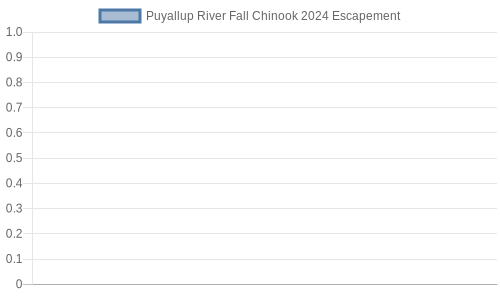
The above graph will update every Thursday typically with the fish that have returned to the hatchery on the Carbon River.
When to fish for fall chinook salmon on the Puyallup River?
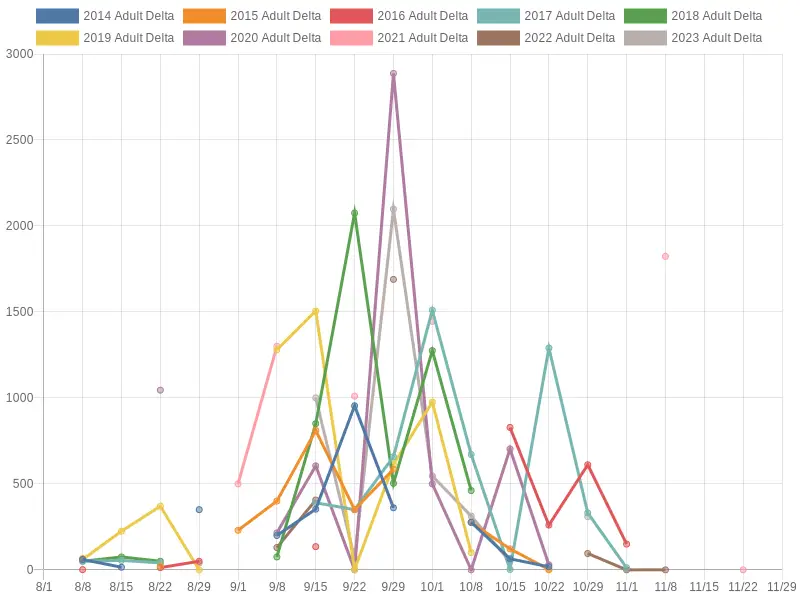
When looking at a chart like the above, you want to visually ascertain when the run really begins to be fishable in most years. Most years that’s as soon as it opens up in early August. It usually peaks in early September / late August though on the Puyallup, particularly the lower parts of the river.
Forecast for 2024 Puyallup River Fall Chinook Salmon
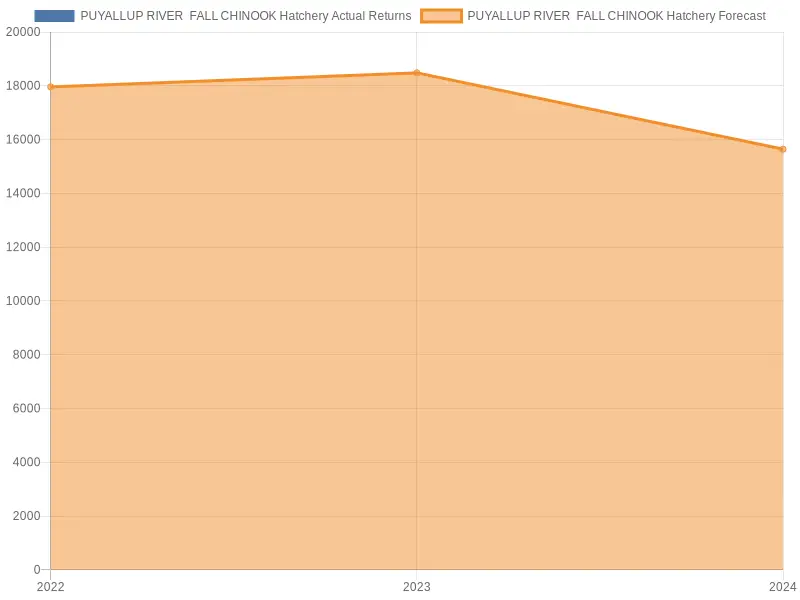
The forecasted run of fall chinook salmon on the Puyallup is expected to be lower in 2024 than in both 2022 and 2023 by a few thousand fish.

The escapement in 2023 was almost 2x that of 2022 despite a similar forecast. 2024 returns will likely be between 2500 and 4000 fall chinook.
How to fish for fall chinook salmon on the Puyallup River?
Believe me, I get it. Just getting started fishing for salmon in the river can be pretty intimidating. You may have tried in the past and not had success, you may have grown up fishing, but never in the rivers for salmon.
Don’t worry, literally my entire website is here to help new people get started successfully in a variety of PNW outdoor harvest opportunities, but certainly, salmon fishing in the rivers is well within the wheelhouse.
Don’t find what you’re looking for? Drop me an email at kyle@pnwbestlife.com and I will attempt to answer your question directly.
So let’s look at a few articles starting with a few guides to gear that may help you.
My guide to the best fishing rod for salmon will give you an idea of how to get started AND why you should buy a given salmon fishing rod.
My guide to the best fishing reel for salmon goes with the fishing rod guide to help you complete your setup.
Next, let’s take a deeper look at river fishing for salmon in general. River fishing for salmon is one of the most complete references to salmon fishing the rivers you will find on the interweb.

Why is the Puyallup River the color of a chocolate milkshake during the summer?
The primary source of summertime water in the Puyallup comes from melting glaciers on the slopes of Mount Rainier. While many rivers are sourced by freshwater springs, mountain lakes, or some combination, the Puyallup is almost entirely coming from that glacier melt water during the summer in particular.
Melted glacier water includes extremely fine particulates called silt or glacial till. The water is not “dirty” as some would believe; it’s also going to be quite cold and thus dangerous if appropriate precautions are not taken.
Here’s an example of how this impacts your visit to the Puyallup River:
If you are new to rivers, you may not know how to read the surrounding landscape and what it says about the depth of the water. Most people are used to “seeing the bottom” to determine the depth.
Well how do you do that if you can only see through about 1″ of water in the Puyallup? You had better have a plan if you are stopping off the side of the road and hopping into the river. The spot you could be stepping into could be 6″ or 6′ and mean the difference between a nice day of fishing vs life life-threatening situation.
Here’s a few ideas:
- Hold on to something as you take that first step into the water
- Grab a nearby stick and use it to find bottom
- If the current is slow it’s more likely to be shallow (but not always!), if it’s fast and you cannot see bottom, don’t do it.
- Look at the surrounding land, does it gently slope into the water, or is the drop more vertical?
- My favorite: watch someone go in first 🙂
Know that the low visibility will also drastically impact fishing. To get a river salmon to bite in 1″ of visibility you need scent, slow-moving bait, and to put it right at eye level.
What’s the best way to fish the Puyallup River?
You are going to want to use the drift fishing method because of what I wrote about the 1″ visibility. Drift fishing for salmon is covered in way more detail in the link here.
You might also try float fishing for salmon, but need slow enough current and need to get down to right in front of their face.
Why does everyone line up in the river and fish so close together?
The part of the river with the most fish per CFS of water is going to be the choke point. The choke points typically occur in the deep sections of gravel bars. Gravel bars are also super easy to wade on due to their gradual slopes and wide bank areas.
These spots will attract the most bank anglers. Classic bars on the lower part of the river like the “Soccer fields” will be the busiest places on the whole river to fish. If you are looking for a little bit of privacy, you will need to find a place not so ideal to fish.
It all depends on what you are hoping to get out of the fishing experience.
Why do people use such long drift leaders on a river with like 1″ of visibility?
People like it when the fish bite, but they also hate it when the guy or gal next to them is hooking a fish every cast and they aren’t. The answer? Longer leaders such that if the fish doesn’t bite, there’s at least a better chance for the line to run through the mouth of an upstream traveling salmon. A technique called flossing, you can read a ton about here.
Puyallup River Coho Salmon Fishing 2024
Updated status on hatchery coho returning to the Puyallup River
Coho salmon fishing on the Puyallup can be excellent, even as early as August when the river opens. You won’t expect to see large-sized coho typically until late October or into November, but fishing can still be great.
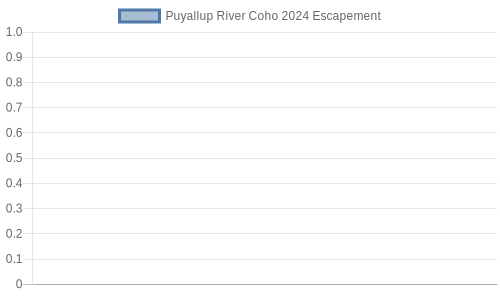
The above graph will be updated every Thursday typically with the coho salmon that have returned to the hatchery on the Carbon River.
When to fish for coho salmon on the Puyallup River?
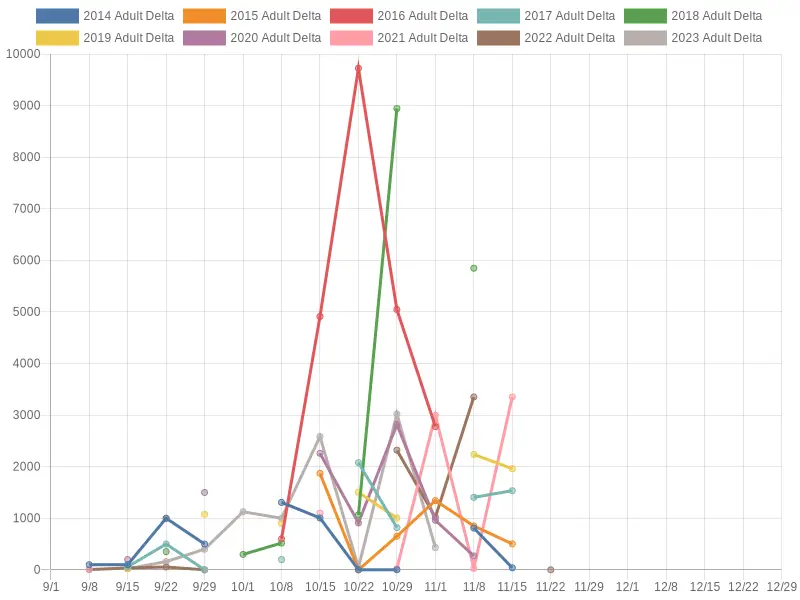
When looking at a chart like the above, you want to visually ascertain when the run really begins to be fishable in most years. My favorite time to fish for coho salmon on the Puyallup is in late September when some rains and cooler temps improve the river clarity. With better visibility, I can toss lures for coho salmon and expect some savage takes!
How to fish for coho salmon on the Puyallup River?
I have several important resources on PNWBestLife.com and the YouTube channel to help you become a better winter steelhead angler.
The same information about chinook salmon applies here to coho except for one major difference: When the Puyallup River clears up you can use lures more effectively like spinners and jigs to catch coho salmon instead of relying on “drift flossing.”
The take of a coho salmon on a spinner is so much more fun than what a flossed fish feels like. Luckily for you, I wrote a complete guide to spinner fishing for salmon here that can help you get started.
You can also view the above video on my YouTube channel (PNW Best Life) for another way to consume similar material.
Fishing Regulations on the Puyallup River for 2024-2025
| Species | Date | Additional Rules |
from the 11th St. Bridge to 400’ downstream of Clark’s CRC (804) |
||
All species |
Aug. 16-Sept. 30 |
CLOSED Sundays, Mondays, and Tuesdays. |
Aug. 16-Oct. 31 |
Anti-snagging rule. Barbless hooks required. Night closure. |
|
Trout |
Aug. 16-Oct. 31 |
Statewide min. size/daily limit. Except: Release cutthroat trout and wild rainbow trout. |
Other game fish |
Aug. 16-Oct. 31 |
Statewide min. size/daily limit. |
Salmon |
Aug. 16-Oct. 31 |
Min. size 12”. Daily limit 6 including no more than 2 adults. Release chum and wild Chinook. |
from 400’ downstream to 400’ upstream of Clark’s Creek |
||
All species |
CLOSED WATERS. |
|
from 400’ upstream of Clark’s Creek to East Main Bridge CRC (804) |
||
All species |
Aug. 16-Oct. 31 |
Barbless hooks required. Anti-snagging rule. Night closure. |
Aug. 16-Sept. 30 |
CLOSED Sundays, Mondays, and Tuesdays. |
|
Trout |
Aug. 16-Oct. 31 |
Statewide min. size/daily limit. Except: Release cutthroat trout and wild rainbow trout. |
Other game fish |
Aug. 16-Oct. 31 |
Statewide min. size/daily limit. |
Salmon |
Aug. 16-Oct. 31 |
Min. size 12”. Daily limit 6 including no more than 2 adults. Release chum and wild Chinook. |
from East Main Bridge to Carbon River CRC (804) |
||
All species |
Aug. 16-Oct. 31 |
Night closure. Barbless hooks required. Anti-snagging rule. |
Aug. 16-Sept. 30 |
CLOSED Sundays, Mondays, and Tuesdays. |
|
Trout |
Aug. 16-Oct. 31 |
Statewide min. size/daily limit. Except: Release cutthroat trout and wild rainbow trout. |
Other game fish |
Aug. 16-Oct. 31 |
Statewide min. size/daily limit. |
Salmon |
Aug. 16-Oct. 31 |
Min. size 12”. Daily limit 6 including no more than 2 adults. Release chum and wild Chinook. |
from Carbon River upstream CRC (804) |
||
All species |
Selective gear rules. |
|
Trout |
Sat. before Memorial Day-Jan. 15 |
Statewide min. size/daily limit. Except: Release cutthroat trout and wild rainbow trout. |
Other game fish |
Sat. before Memorial Day-Jan. 15 |
Statewide min. size/daily limit. |
Please refer to WDFW’s emergency rules page for a full list of rules that are in effect.
It’s your responsibility as the recreational angler.
Here’s a link to the 2022 blog post explaining why the Puyallup River above the White River and the Carbon River are not open 7 days a week anymore.
Where to fish for salmon on the Puyallup River
Here are some maps that show you where the regulations apply on a map.
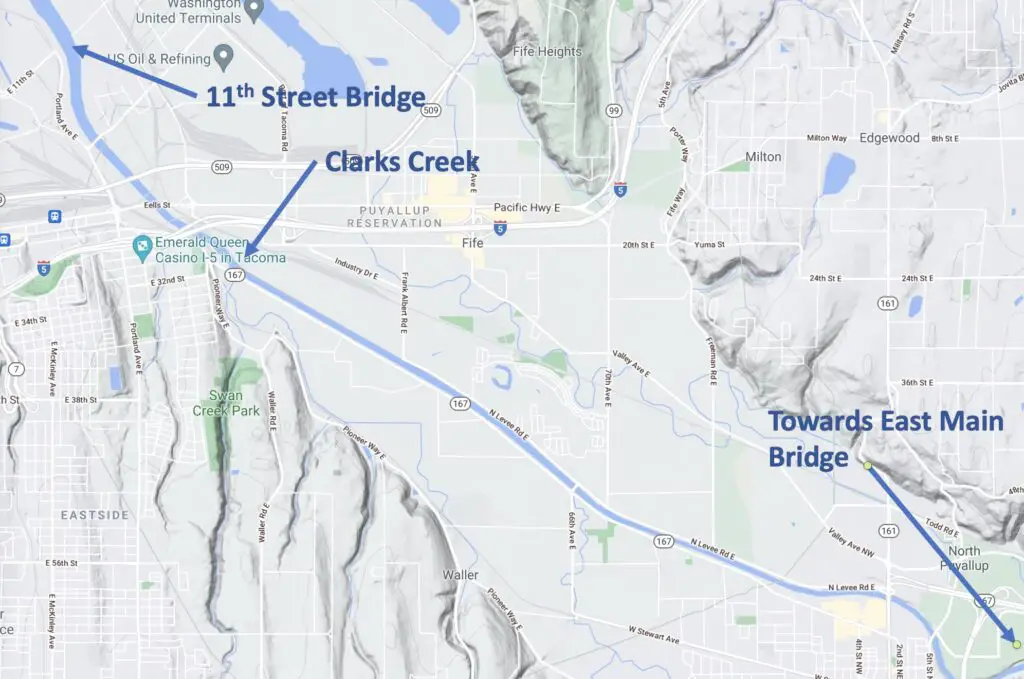
The stretch from the 11th Street Bridge to East Main usually experiences the most angling pressure and it’s also where salmon of all species are the freshest and provide the best quality table fare.
Additionally, many of the returning salmon on the Puyallup are headed to the White River. As soon as you go upstream of the East Main Bridge, you lose those white river fish.

Here you can see, in the above map a more clear view of the white river coming into the Puyallup from the NE.
The stretch from East Main to the mouth of the Carbon River can also provide great fishing, albeit with less salmon and slightly less angling pressure
I would love to update this post and draw maps to all the popular spots to make it easy for folks, but it’s also pretty easy to just drive the roads on either side of the river and discover where everyone else is parking.
There really are no (almost no?) secrets here.